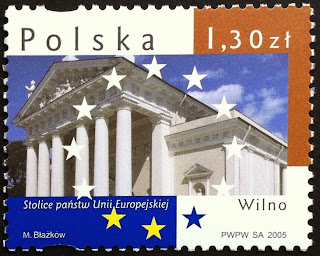Friday, December 27, 2013
The capitals of the E.U. member states: Vilnius 2005
A very nice looking FDC and the stamp issued by Poland in 2005 as one of the series of the capital cities of the European Union member states. The design of the FDC cover is especially nice! Curiously, a stamp depicting the Wilno/Vilnius cathedral with similar angle has also been issued by Poland during the prewar occupation period as well.
Thursday, December 12, 2013
Eišiškės 1932
Here is a prewar Polish stamp with a postmark of Ejszyszki (now Eišiškės, Lithuania, also known as Ejszyszok in Jewish) cancelled in 1932, during the Polish occupation. Located in the south east of Lithuania, just 500 meters from the present border of Belarus, Eišiškės have experienced a pretty complex history especially between 1919 and 1945, which makes the town's postal history very interesting.
Priekulė 1907
 |
| Prökuls (now Priekulė) postmark 1907 |
 |
| Heydekrug (now Šilutė) arrival cancellation |
 |
| Not an envelope but a folded letter itself |
This is cover sent in 1907 from Prökuls (now Priekulė, Lithuania) to Heydekrug (now Šilutė, Lithuania). Both Prökuls and Heydekrug are part of Memel region which was itself part of Germany at that time. When I first got this cover, I was pretty surprised by the finesse and softness of the paper quality of the envelope but... I was wrong actually. It wasn't an envelope, this he or she, used the letter itself as an envelope, thus explains the high quality of the paper material.
Priekulė is another source of "mix up", sometime mistaken with a Latvian town: Priekule, which is unconveniently located not only to the Lithuanian border but near Klaipėda district. This Latvian town was called Preekuln in German so philatelically (or philatelicly?? I'm always not sure..) speaking it should not cause a problem but for postcard collectors it can be a problem.
 |
| German Field post (Feldpost) card sent in 1919 from Preekuln Bahnhof (railway station), now Priekule, Latvia |
Thursday, December 5, 2013
Cancellations of the First Republic - 03
Priekulė 1925 and 1935, former Prökuls, Memelgebiet
Raseiniai 1924 and 1933
Didkiemis 1939, a village in Tauragė county with a population of 220
Dusetos 1925, a village in Utena county with a population of 870
Tuesday, December 3, 2013
Joniškis 1916
This is a German field post (Feldpost) card of Janischky (now Joniškis, Lithuania) sent in 1916 from the field post station 264 to Imlingen bei Saarburg, Lothringen, Germany (now Imling, Lorraine, France). Saarburg is also part of France today with the name Sarrebourg.
Joniškis is also a confusing town just like Abeli/Obeliai which I have posted previously, located near the border with Latvia. So far I have encountered the spellings: Janischky, Janiszki, Jonišķi. We see lot of people on the picture, even cars (I see at least 4 of them)... Sunday mass? Wedding? Easter? I can tell it is not during the winter but what is it, I don't know. Joniškis has a big church comparing to the size of the town, with an enormous bell tower you can see from far away when driving from Šiauliai and looks like as if the long straight road is directly leading to this tower. Curiously, same phenomenon happens with the bell tower of the cathedral of Šiauliai when you drive from Joniškis.
Obeliai 1916
This is German military field post (Feldpost) card of Abeli (now Obeliai, Lithuania) sent in 1916 to Scholderup, Schleswig (now Taarstedt, Schleswig-Holstein), Germany. Abeli is very often mistaken to be part of Latvia. This town was mentioned as part of Kurland (Courland) in most of the documents prior to WWI, because the term "Kurland" was purely geographic to most the Germans at that time. Today the simple formula: Kurland = Kurzeme therefore Kurland = "part of Latvia" is followed by most of the non-Latvian people. In addition to this, there is a town called Ambeļi near Daugavpils not far from the Lithuanian border, which for some unknown reason, sometime mistakenly spelled "Abeļi". If you are in doubt to identify a picture, the church you see on this postcard can be your best bet, it remains exactly in the same shape in today's Obeliai.
Subscribe to:
Posts (Atom)


























